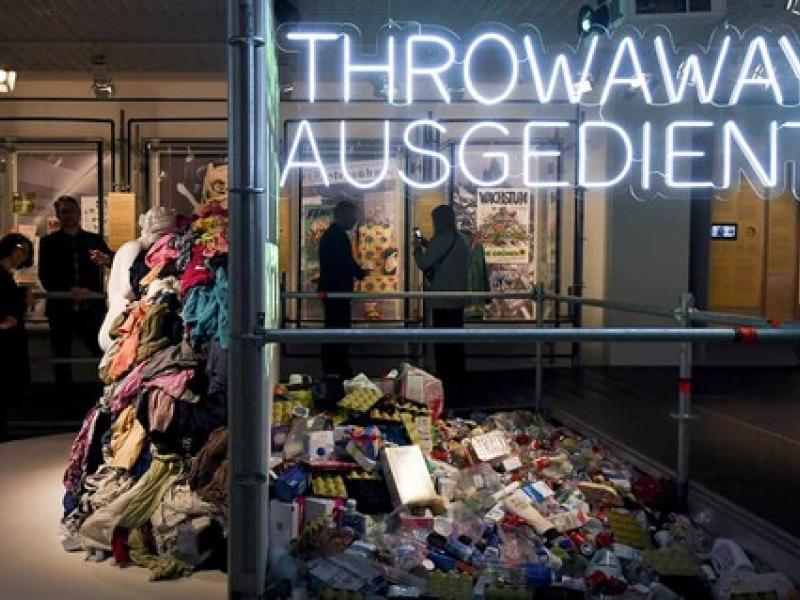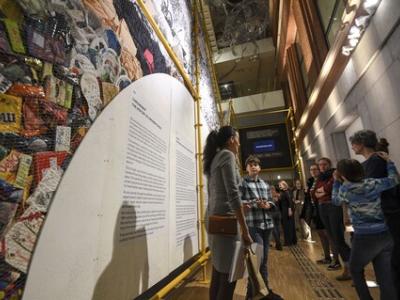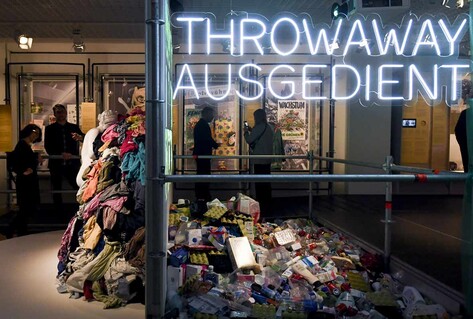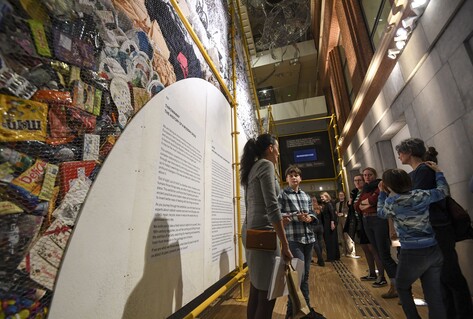
In a circular exhibition, materials employed to build the structures, the walls, and to make the exhibition work, have been used before the exhibition and will continue their life afterwards (fully circular materials), or are made from reused or recycled materials (semi-circular). For instance, in the Throwaway exhibition, the whole structure supporting scenography and showcases uses scaffolding, a fully circular material that is used multiple times in construction sites. The exhibition panels are plastic walls made of recycled bottles and bags, and will be reused afterwards.
The museum worked with the Brussels-based cooperative design practice Rotor in order to include metrics for measuring the exhibition’s impact in terms of waste production in the call for tenders for the exhibition’s design and production. We asked the selected candidate, Ypunto Ending, to appoint a circularity manager who would be responsible for sourcing circular material to create the exhibition: they brought into the project the Madrid-based collective Basurama.
For Basurama, creating in a circular way is based on “the need to connect institutions with their urban environments, the urgency of generating higher-quality public spaces that support increasingly complex urban contexts, the engagement of individual and collective citizen participation as a non negotiable tool for action and management, and, of course, the use of rubbish as a means to question our way of exploiting resources, our way of thinking, working and perceiving reality.” (Mónica Gutiérrez Herrero and Manuel Polanco Pérez-Llantada, Basurama).
With their help, we became aware of the type and amount of waste our museum is producing on a daily basis. We collected our rubbish over a period of ten months and Basurama created an installation out of it at the entrance of the exhibition. With them, we also mapped out the wide and well-connected network of people and companies in Brussels that work in the field of circularity, many of them already professionalised and open to collaborating. An example of one of these partners is Bel Albatros, based at RecyK, that is dedicated to researching production methods made of plastic for large surfaces, and produced our exhibition panels. Working with people from this field made us understand that circularity is as much a creative process as a management activity, with the potential to produce an aesthetic in accordance with the challenges of our time.
What challenges did we face to produce an exhibition that is not only circular but more largely environmentally-friendly? There are conservation requirements that come with exhibiting museum collections of historical objects that prevented us from applying reuse and circularity across all components of the scenography. Often, reusing through renting is more expensive than buying. Moreover, as a European museum, we have collaborators in different countries, which means international transport: we launched an EU-wide call for tenders and selected a Spanish company to design and produce the exhibition; we exhibit objects coming from museums and collections across the continent.
We will not know precisely how circular the Throwaway exhibition turns out to be until well after it has been dismantled in early 2024. The challenges are high to produce ‘greener’ exhibitions, but we definitely embarked on a journey towards recovery, redesign and reuse, through a process of trial, error, self-criticism and progress, and towards models that are more socially and environmentally just.
Cover image: taken during installation of the Venus of the Rags, Mixed media sculpture by Michelangelo Pistoletto
Gallery images: EU, European Parliament




